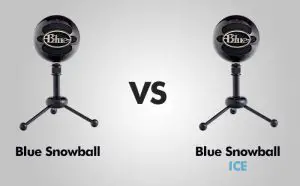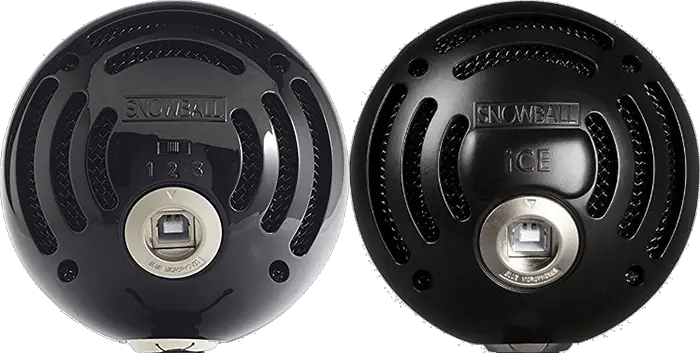
A few months ago, I created a post where I compared two microphones – Blue Snowball and Yeti to find out whether a much cheaper Snowball can be a good alternative to Yeti.
This time, I would like to compare if even cheaper Snowball ICE can be considered as an option to already affordable Snowball.
Specs
| Snowball | Snowball ICE | |
|---|---|---|
| Sample Rate | 44.1 kHz / 16 bit | 44.1 kHz / 16 bit |
| Frequency Response | 40 –18 kHz | 40 –18 kHz |
| Weight | 460 gram | 460 gram |
| check price | check price |
Build quality
Both microphones are very similar when it comes to design – they look like a … snowball, at least the white ones.
They resemble an old-school vintage look with a big “Blue” logo at the front. At first it looks like metal, but in reality, it’s just plastic.
The mics come with a tripod that doesn’t require too much space, but at the same time the mic will fall over a lot, so be sure that you pushed its legs all way down and try not to knock it off.
The tripod is equipped with rubber grips in order to keep is secure and ensure that it will stay in place.
The Snowball is available in six different colors: white, bright orange, brushed aluminum, electric blue, gloss black, neon green.

And the Snowball ICE in two – black and white.

Sound quality
The sound quality is very good in this price range. Probably better than any other microphone currently available on the market.
It sounds good in the full range of frequencies. You don’t have to be very close to the microphones unless you speak very quietly, but if you talk normally, you can be between 3 and 7 inches.
The sound quality is excellent and if you have a youtube channel this should be your choice. For someone who needs even better quality should choose Yeti.
Features
As I’ve said before, there is no difference when you look at them from the front, but turn them around and you will notice that the standard Snowball has an additional switch that ICE lacks.

This switch is used to change polar patterns. The Snowball ICE uses only one mode – the cardioid mode, so it doesn’t need any switch.
| Pattern Modes | Symbol | Snowball | Snowball ICE |
|---|---|---|---|
| Cardioid Records sound that is directly in front of the microphone. (podcasts, game streaming, sung vocals, instruments, voice-overs). |  | YES | YES |
| Cardioid Mode with -10 dB PAD The same as cardioid mode, except with a -10 dB attenuation that helps you capture louder sounds with higher fidelity. In other words – it reduces microphone sensitivity. |  | YES | NO |
| Omnidirectional Captures sound equally from all around the mic. (recording band live performace, multi person podcast, conference call). |  | YES | NO |
Additional Purchases
Although you can use your microphone right away, there are some additional things that can be a good addition to your Snowball.
Pop filter
When you speak toward your microphone, you often produce something called the “popping” sound. This is caused by the impact of fast-moving air. The pop filter will help you eliminate this problem.


Shock mount
After placing your microphone on a hard surface, the sound can be distorted. The shock absorber connects with a microphone elastically, so vibrations won’t be a problem.


Arm
Many people find it useful the ability to maneuver a microphone. With this arm, you can do it with ease.


Pros and Cons
| Snowball | Snowball ICE |
|---|---|
| PROS: – Good sound quality – Decent build quality – Retro feel – Three audio settings – Metal stand – Light – Noise-cancellations. | PROS: – Good sound quality – Decent build quality – Retro feel – Metal stand – Light – Noise-cancellations. |
| CONS: – The microphone can be easily knocked down. | CONS: – One audio setting – Microphone can be easily knocked down. |
| check price | check price |
Conclusion
The difference in price between standard Snowball and Snowball ICE used to be $20. Today you can buy Snowball at almost the same price as ICE (for some colors). In this case, I don’t see why anyone should go with Snowball ICE.
Disclosure: This post contains affiliate links. As an Amazon Associate, I earn from qualifying purchases. This means that if you make a purchase through one of these links, I may earn a small commission at no additional cost to you. Thank you for your support!
